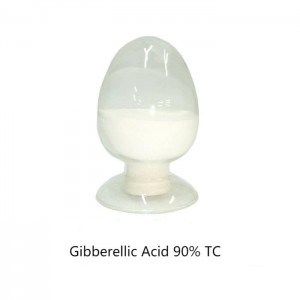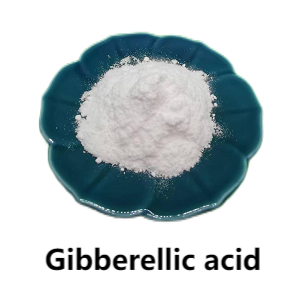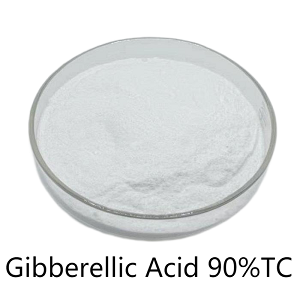Giberelična kiselina 10%TA
| Naziv proizvoda | Giberelična kiselina |
| Sadržaj | 75%TC; 90%TC 3%EC 3%SP, 10%SP; 20%SP; 40%SP 10%ST;15%ST |
| Izgled | Bijeli kristalni prah |
| Aplikacija |
|
Fiziološki efekat
Podstiču izduživanje i rast stabljika
Najznačajniji fiziološki efekat giberelinske kiseline (giberelina) je podsticanje rasta biljaka, uglavnom zato što može podsticati izduživanje ćelija. Podsticanje rasta GA ima sljedeće karakteristike:
1. Tretman GA može značajno potaknuti rast stabljika biljaka, posebno kod patuljastih mutiranih sorti, kao što je prikazano na slici 7-11. Međutim, GA nije imala značajan utjecaj na izduživanje izoliranih segmenata stabljike, dok je IAA imala značajan utjecaj na izduživanje izoliranih segmenata stabljike. Razlog zašto GA potiče izduživanje patuljastih biljaka je taj što je sadržaj GA u patuljastim vrstama niži nego u normalnim vrstama zbog opstrukcije endogene sinteze GA.
2. Podsticanje izduženja internodija GA uglavnom djeluje na postojeće izduženje internodija, umjesto da podstiče povećanje broja čvorova.
3. Ne postoji inhibitorni efekat superoptimalne koncentracije. Čak i ako je koncentracija GA vrlo visoka, ona i dalje može pokazati maksimalni promotivni efekat, što se značajno razlikuje od situacije u kojoj auksin promoviše rast biljaka s optimalnom koncentracijom.
4. Reakcija različitih biljnih vrsta i sorti na GA je vrlo različita. Visok prinos može se postići korištenjem GA na povrću (celer, zelena salata, praziluk), travi, čaju, ramiji i drugim kulturama.
Inducirano cvjetanje
Diferencijacija cvjetnih pupoljaka kod nekih viših biljaka zavisi od dužine dana (fotoperioda) i temperature. Na primjer, dvogodišnjim biljkama je potreban određeni broj dana tretmana na niskoj temperaturi (tj. vernalizacije) da bi procvjetale, u suprotnom pokazuju rast rozete bez pucanja cvjetanja. Ako se GA primijeni na ove nevernalizirane biljke, cvjetanje se može izazvati bez procesa na niskoj temperaturi, a efekat je vrlo očigledan. Osim toga, GA može izazvati cvjetanje nekih biljaka dugog dana umjesto biljaka dugog dana, ali GA nema podsticajni učinak na diferencijaciju cvjetnih pupoljaka biljaka kratkog dana. Na primjer, GA može podsticati cvjetanje stevije, željeznog drveta, čempresa i jele.
Prekini mirovanje
Tretiranje krompira u mirovanju sa 2 ~ 3μg·g GA može ubrzati njegovo klijanje, kako bi se zadovoljile potrebe sadnje krompira nekoliko puta godišnje. Za sjeme kojem je potrebna svjetlost i niska temperatura za klijanje, kao što su zelena salata, duhan, perila, šljiva i sjemenke jabuke, GA može zamijeniti svjetlost i nisku temperaturu kako bi se prekinuo mirovanje, jer GA može inducirati sintezu α-amilaze, proteaze i drugih hidrolaza, te katalizirati razgradnju uskladištenih supstanci u sjemenu za rast i razvoj embrija. U industriji proizvodnje piva, tretiranje pupoljaka ječma bez klijanja sa GA može inducirati proizvodnju α-amilaze, ubrzati proces saharifikacije tokom kuhanja i smanjiti respiratornu potrošnju klijanja, čime se smanjuju troškovi.
Podstiču diferencijaciju muških cvjetova
Udio muških cvjetova povećao se nakon tretmana GA kod biljaka iste vrste. Ženske dvodomne biljke, ako se tretiraju GA, također će proizvoditi muške cvjetove. Učinak GA u tom pogledu je suprotan učinku auksina i etilena.
Fiziološki efekat
GA također može pojačati mobilizacijski učinak IAA na hranjive tvari, potaknuti zametanje plodova i partenokarpiju nekih biljaka, te odgoditi starenje listova. Osim toga, GA može potaknuti i diobu i diferencijaciju ćelija, a GA potiče diobu ćelija zbog skraćivanja G1 i S faze. Međutim, GA inhibira formiranje adventicijskih korijena, što je različito od auksina.
Način upotrebe
1. Podsticati formiranje plodova ili plodova bez sjemenki. Poprskati krastavac sa 50-100 mg/kg tečnosti jednom tokom cvjetanja kako bi se podstaklo formiranje plodova i povećao prinos. 7-10 dana nakon cvjetanja, mirisne ruže su poprskane sa 200-500 mg/kg tečnosti jednom kako bi se podstaklo formiranje plodova bez koštica.
2. Podstaknite rast celera 2 sedmice prije berbe, poprskajte listove jednom tečnim lijekom od 50-100 mg/kg; Poprskajte listove 1-2 puta 3 sedmice prije berbe kako biste povećali stabljike i listove.
3. Prije sjetve krompira, gomolje natopite rastvorom od 0,5-1 mg/kg 30 minuta kako biste prekinuli mirovanje i podstakli klijanje; Namakanje sjemena sa 1 mg/kg tečnog lijeka prije sjetve može podstaći klijanje.
4. Efekat protiv starenja i očuvanja svježine: Bijeli luk sa 50 mg/kg medicinskog rastvora tokom 10-30 minuta, agrumi zelenog voća sa 5-15 mg/kg medicinskog rastvora, banane nakon berbe sa 10 mg/kg medicinskog rastvora, voće potopiti u vodu, krastavac, lubenicu prije berbe sa 10-50 mg/kg medicinskog rastvora, dinju poprskati, što može imati efekat očuvanja svježine.
5. Podesite fazu vernalizacije cvjetajuće krizanteme sa 1000 mg/kg tečnog spreja za listove, a fazu pupoljaka ciklame sa 1-5 mg/kg tečnog spreja za pupoljke može podstaći cvjetanje.
6. Da bi se poboljšala stopa zametanja sjemena hibridne riže, proizvodnja se obično počinje pri 15% formiranju glavice matične biljke i tretira se sa 25-55 mg/kg tečnog lijeka 1-3 puta na kraju formiranja 25% glavice. Prvo se koristi niska koncentracija, a zatim visoka koncentracija.
Stvari koje zahtijevaju pažnju
1. Giberelična kiselina je manje rastvorljiva u vodi, pre upotrebe se rastvara u maloj količini alkohola ili tečnosti, a zatim razblažuje vodom do potrebne koncentracije.
2. Sterilnost sjemena usjeva tretiranih gibereličnom kiselinom se povećala, tako da nije pogodno primjenjivati lijek na poljima sadnje.














